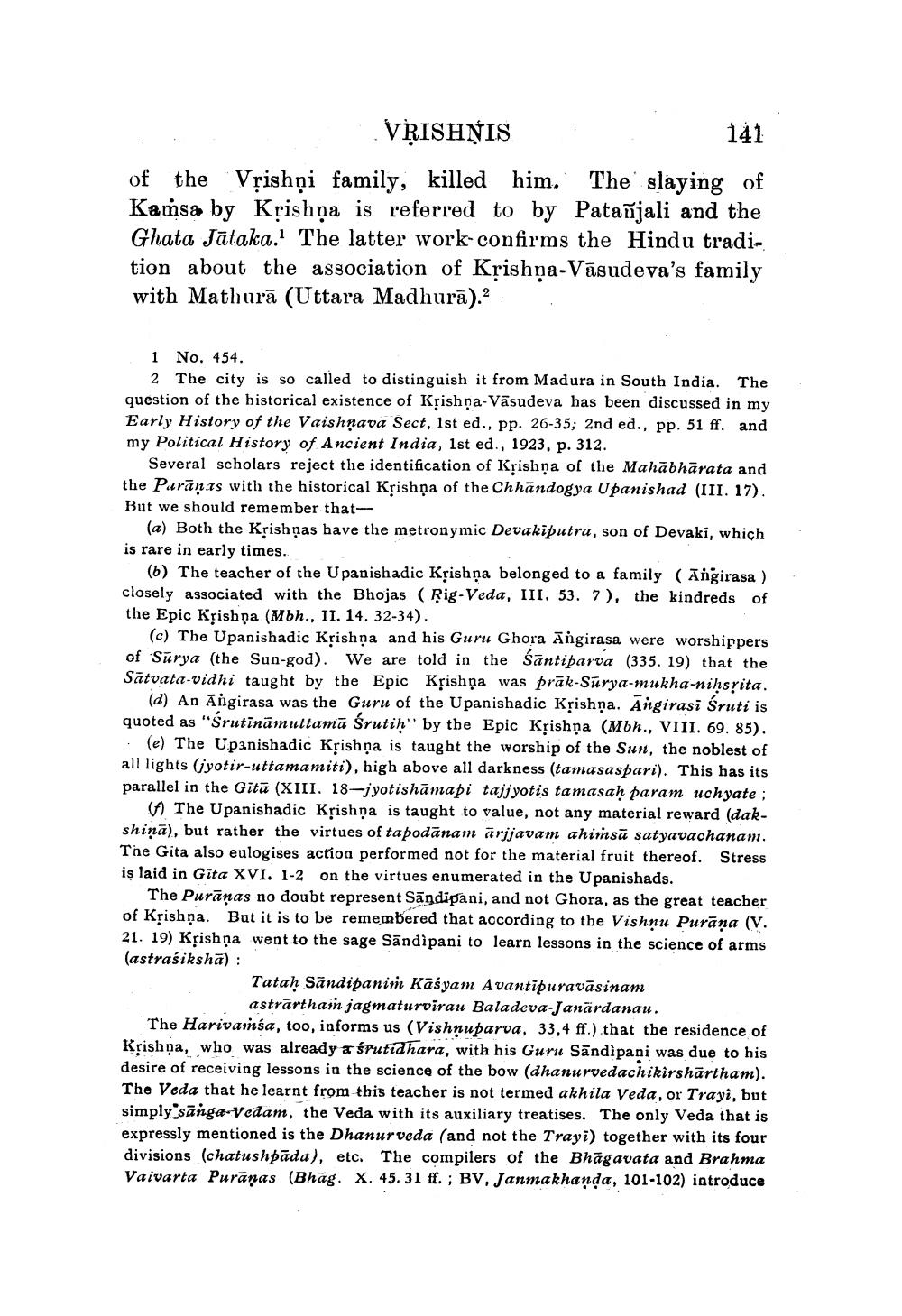________________
VĶISHNIS
141 of the Vrishội family, killed him. The slaying of Kamsa by Krishộa is referred to by Patañjali and the Ghata Jātaka. The latter work-confirms the Hindu tradition about the association of Krishịa-Vāsudeva's family with Mathurā (Uttara Madhurā).?
1 No. 454.
2 The city is so called to distinguish it from Madura in South India. The question of the historical existence of Krishna-Vasudeva has been discussed in my Early History of the Vaishnava Sect, 1st ed., pp. 26-35; 2nd ed., pp. 51 ff. and my Political History of Ancient India, 1st ed., 1923, p. 312.
Several scholars reject the identification of Krishna of the Mahābhārata and the Purānas with the historical Kțishņa of the Chhāndog ya Upanishad (III. 17). But we should remember that
(a) Both the Krishņas have the metronymic Devakiputra, son of Devaki, which is rare in early times.
(6) The teacher of the Upanishadic Kệishņa belonged to a family (Angirasa ) closely associated with the Bhojas (Rig Veda, III, 53. 7), the kindreds of the Epic Kệishņa (Mbh., II. 14. 32-34).
(c) The Upanishadic Krishịa and his Guru Ghora Angirasa were worshippers of Sürya (the Sun-god). We are told in the Santiparva (335. 19) that the Satvata-vidhi taught by the Epic Krishọa was prāk-Sürya-mukha-nihsrita.
(d) An Angirasa was the Guru of the Upanishadic Krishna. Angirasi Śruti is quoted as "Śrutināmuttamā śrutih" by the Epic Krishņa (Mbh., VIII. 69. 85). . (e) The Upanishadic Kệishna is taught the worship of the Sun, the noblest of all lights (jyotir-uttamamiti), high above all darkness (tamasaspari). This has its parallel in the Gitā (XIII. 18-jyotishāmapi tajjyotis tamasah param uchyate ;
The Upanishadic Kțishna is taught to value, not any material reward (dakshinā), but rather the virtues of tapodānam ärijavam ahirsā satyavachanam. The Gita also eulogises action performed not for the material fruit thereof. Stress is laid in Gita XVI. 1-2 on the virtues enumerated in the Upanishads.
The Purānas no doubt represent Sāŋdipani, and not Ghora, as the great teacher of Krishna. But it is to be remembered that according to the Vishnu Purana (V. 21. 19) Krishna went to the sage Sandipani to learn lessons in the science of arms (astraśiksha):
Tataḥ Sändipanim Kāśyam Avantipuravāsinam
astrārthai jagmaturvirau Baladeva-Janārdanau. The Harivainsa, too, informs us (Vishnuparva, 33,4 ff.).that the residence of Krishộa, who was already a śrutidhara, with his Guru Sāndipani was due to his desire of receiving lessons in the science of the bow (dhanurvedachikirshārtham). The Veda that he learnt from this teacher is not termed akhila Veda, or Trayi, but simply sānga-Vedam, the Veda with its auxiliary treatises. The only Veda that is expressly mentioned is the Dhanurveda (and not the Trayi) together with its four divisions (chatushpāda), etc. The compilers of the Bhāgavata and Brahma Vaivarta Puranas (Bhāg. X. 45.31 ff.; BV, Janmakhanda, 101-102) introduce




